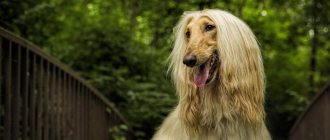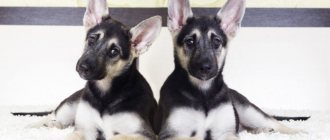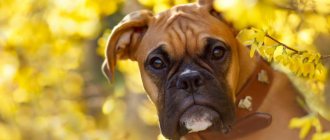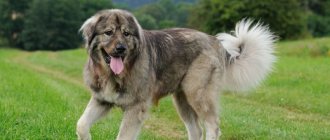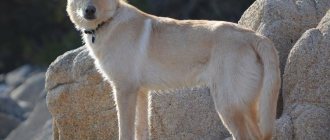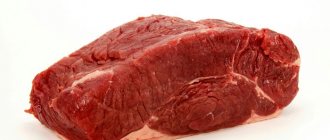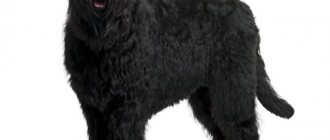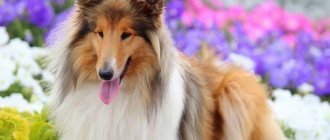The East European Shepherd is the personification of boundless devotion and enormous intelligence. Despite the fact that the breed is not recognized by world canine organizations, the smartest dogs are still actively bred and valued in the countries of the former USSR. Such determination of domestic dog handlers and loyalty to the breed is due to the outstanding qualities of the breed: amazing endurance, extraordinary intelligence, high performance and sincere friendliness.
VEO is a universal dog that will faithfully serve in law enforcement agencies or become a loyal friend and constant protector of all members of the owner’s family. Before purchasing a cute East European Shepherd puppy, it is useful for the future owner to learn everything about the breed: history of origin, standards and character, features of care, feeding and training.
Description of the East European Shepherd breed
Popularity 6th among 263 dog breeds
Lifespan:
12-13 years old
Breed group:
Service
Height:
males: 66-76 cm, females: 62-72 cm
Country of origin:
Russia
Average price:
15-20 thousand rubles
Weight:
males: 35-60 kg, females: 30-50 kg
Latest articles Cat health
Ataxia in cats: what is it, how does it manifest and is treated 01/23/2022 180 0 0
Cat health
Leukemia, or viral leukemia in cats 01/23/2022 156 0 0
Height and weight of an East European Shepherd puppy by month
A VEO puppy reaches the size and weight of an adult animal at 8-9 months, but muscle formation and an increase in the amount of subcutaneous fat continue up to a year. The build of a dog depends on heredity and the quality of feeding and maintenance of growing young animals.
Table of height and weight of the VEO puppy by month
| Age (in months) | Height at the withers of a male dog (cm) | Height at the withers of the bitch (cm) | Weight (kg) |
| 1 | 23-27 | 23-25 | 3-5 |
| 2 | 35-38 | 33-36 | 8-10 |
| 3 | 43-47 | 41-46 | 12-15 |
| 4 | 50-55 | 48-53 | 15-20 |
| 5 | 55-60 | 55-57 | 20-25 |
| 6 | 60-65 | 57-65 | 25-30 |
| 7 | 65-68 | 65-66 | 30-35 |
| 8 | 68-70 | 66-67 | 35-40 |
| 9 | 68-73 | 66-68 | 35-40 |
| 10 | 68-75 | 66-69 | 35-40 |
| 11 | 68-75 | 66-69 | 35-40 |
| 12 | 68-75 | 66-69 | 35-40 |
Changes also occur in other parameters of the shepherd dog.
Key facts
The East European Shepherd (abbreviated VEO) is the pride of Soviet and Russian breeders. The historical development of the breed was practically not affected by the human factor, which was able to protect dogs from a large number of diseases transmitted from generation to generation. Even abroad, many breeders prefer to buy Russian dogs - the characteristics of the East European Shepherd breed allow us to consider it the most promising in work.
A shepherd dog is, first and foremost, a service dog, which means it definitely needs to take OKD and ZKS courses. Only after they are completed can the owner be sure that his pet will not attack a passerby and will behave normally in society.
Owning a shepherd as a pet is a big mistake. This breed exists for work or sport. This animal cannot live in the conditions of a lap dog, and the description of the East European Shepherd breed emphasizes this.
Although these dogs are adapted to frost, they can easily be knocked down by dampness or drafts. You cannot leave your animal outside in rain or wet weather, even in a kennel. The exception is a heated kennel.
Shepherd dogs mature fully only by the age of 3. Until this time, you should be lenient about dog pranks. The dog may look like a huge and adult dog on the outside, but inside he is still a puppy.
The health of these service dogs is excellent - all thanks to small selection work. The average lifespan of an East European Shepherd is 11-13 years, which is a good length of time for large dogs.
Application of VEO
VEO is a universal service dog. She can handle any discipline, but she is best suited for security, guard, protective and search directions.
The East European Shepherd is used for:
- detection of drugs and explosives;
- defense;
- search and detention of criminals;
- protection of the territory.
Occasionally, VEO is trained as a guide dog. The characteristics of the breed include a balanced, calm temperament, which makes the dogs good caregivers. But in this matter they are superior to Labrador Retrievers.
Things are worse with sports. East European Shepherds are large, heavy, it is difficult for them to take hurdles, they move slower than the same BUT, collie, and Spitz. However, they are trained in canicross, weight-pulling, and agility.
History of the origin of the East European Shepherd
In the 30-50s of the last century, the USSR actively developed breeds of service dogs. Due to state necessity, East European Shepherds also appeared. Their main concern at that time was guard and escort service in the now well-known Gulag. However, in those days this, of course, was not advertised.
The breeding material was a German Shepherd. The best individuals were carefully selected and trained. Thanks to her, during that period the USSR developed several breeds of “superdogs”.
After the Second World War, there were almost no shepherd dogs left in domestic kennels, which meant that work on improving and developing the breed would have to start all over again. Already by the 60s, several breeds appeared at once, which showed excellent performance qualities and also had a pleasant appearance.
The camps and prisons had already disappeared by that time, but the work for these four-legged animals had not gone away. Now almost all of them were in the service of the Ministry of Internal Affairs, but some were used by ordinary people as guide dogs. Well, after such films as “Mukhtar” and “Border Dog Scarlet”, all the children dreamed of their own shepherd dog.
In 1964, appearance standards were drawn up for the breed, but not all world organizations recognized East European Shepherds as a full-fledged breed. Thus, FCI still considers this breed as a variety of German Shepherd.
History of the development of the breed
1904-1905 – during the Russo-Japanese War, the first mentions of “Easterners” are found, who served in the communications and sanitary services. In addition to an increased level of endurance and performance, the new breed was distinguished by unquestioning discipline, selfless devotion and high intelligence.
1922-1940 - with the coming to power of I.V. Stalin continued work to consolidate the positive qualities of the new breed. With increasing repression, the new government needed huge numbers of hardy guard dogs to guard prisoners. In 1924, the Krasnaya Zvezda kennel and service dog breeding clubs were created to control matings, select purebred sires and register offspring. For the further work of dog handlers and breeders who developed a new breed, new purebred German shepherd breeders were required. “German” puppies from Germany were purchased exclusively for foreign currency, but due to a shortage of financial resources and the injection of fresh blood, the selection of VEO was suspended until the end of World War II. During this period, East European and German shepherds in the USSR were often considered the same breed.
1941-1945 – during the Great Patriotic War, about 60 thousand individuals of East European Shepherds were actively used on the front line and in the rear, thanks to which the breed earned recognition and received the name of the most patriotic breed. In honor of the brave and selfless front-line dog, a bronze monument was erected on Poklonnaya Hill in Moscow, the prototype of which was VEO. After the end of hostilities, many adult trophy German shepherds remained on the territory of the USSR, which were used for further breeding of the breed and consolidation of outstanding qualities.
1964-1990 – VEO officially became considered a subspecies of the German Shepherd and received recognized breed standards in 1964 and 1976. Before the collapse of the USSR, Soviet cynologists carried out active breeding work to improve and consolidate the positive breed qualities.
East European Shepherd Efa, winner of exhibitions in 1965, 1966 and 1967.
1991-2002 _ – after the collapse of the USSR, the German Shepherd received an international standard, and the “Eastern Europeans” were recognized as an illegal breed. Representatives of the New Soviet breed were not allowed to participate in exhibitions and were excluded from cynological associations. During this difficult time, the Association of Breeding Kennels VEO and the Union of East European Shepherd Lovers were formed, which are still involved in breeding VEO, controlling matings, preserving the purity of the breed, holding exhibitions and competitions.
In 2002, the Russian Canine Federation officially recognized the East European Shepherd as an independent breed with the approval of modern standards.
Appearance of the East European Shepherd
General impression
By and large, the East European Shepherd is simply a Russian and somewhat enlarged version of the German Shepherd. However, externally it is quite easy to distinguish a German from a Russian Shepherd.
The first thing that will always catch your eye (even in a photo of an East European Shepherd and its brother) is that Easterners are much larger than Germans. The average male German Shepherd is the same in build as the not-largest female VEO.
According to the standard, the height of the East European Shepherd is 66-76 cm for males and 62-72 cm for females. The weight of the East European Shepherd always ranges from 35-60 kg and 30-50 kg, respectively.
Russian Shepherds have a straight back, unlike Germans, who have a strong slant visible to the naked eye. The legs are thicker and larger, causing dogs to move differently.
Head
The skull is flat, slightly widened between the ears, and there is a small groove along the forehead. The stop is smoothed, the brow ridges and the bump on the back of the head are not pronounced. The muzzle is narrow, but not pointed.
The nose is large and completely black. The eyes are regular ovals, set very wide, but slightly askew. The color of the iris is black or dark brown.
The ears are triangular, medium size, erect. Set high and quite wide. If the dog is relaxed, they can be slightly hung. In a wary dog they are raised straight up.
Neck
In relation to the back, it is set at an angle of 40-45 degrees. It widens slightly towards the shoulders. Purebred dogs have a muscular neck, without dewlap.
Torso
The shepherd's body is rectangular. The back is long, almost absolutely straight, strong. The loin is short, slightly convex. The line of the withers and croup are clearly visible. The chest is oval, reaching down to the elbows, with neat ribs. The belly is tucked in.
Forelegs
The front paws of a shepherd are straight and set parallel. The shoulder blades and shoulders are long and oblique. The angle of their articulation reaches 100 degrees. Elbows are pressed tightly to the sides. The pasterns are slightly inclined and springy.
Hind limbs
The hind legs look much more massive than the front legs due to the muscular thighs. The lower legs are slightly elongated, but not elongated. The paws are oval in shape, the toes are gathered into a ball, the pads are hard and completely black.
Movement
The shepherd moves with long strides, slightly waddling from side to side. In case of danger, it can almost instantly start running thanks to its strong hind limbs.
Wool
The coat consists of two layers: a soft, dense undercoat and a long, hard outer coat. The fur reaches its maximum length on the neck and hips, while it is short on the head and paws.
Color
Gray-red and black-gray colors of the East European Shepherd are allowed. There may also be light spots above the eyes, on the paws, on the cheekbones and under the tail. Zone-red coat color is not welcome.
Size
Males of the East European Shepherd grow up to 66-76 cm at the withers and weigh 35-60 kg. For females, these parameters look like this: 62-72 cm at the withers and 30-50 kg. The size of the East European Shepherd is incomparably larger than its German ancestors.
Comparison with the German Shepherd
Comparative characteristics of breeds:
| Comparison criterion | German Shepherd | East European Shepherd |
| Source of origin | Obtained as a result of selection | Obtained as a result of selection |
| Appearance | The ridge line descends at an angle of 23 degrees to the tail, the body of the German varies between 61-77 cm, the hind legs are carried further than the ridge | There is no slope of the ridge, the body is much larger, the hind legs are almost level with the ridge |
| Temperament | Increased energy and sociability | Calmness and distrust of people |
| Training | Easy to train and educate | Easy to train and educate |
| Height at withers Weight Ridge/back Purpose Color | Up to 65 cm Up to 40 kg Inclined Search work, sports competitions, work in pastures, watchman Black, black, zoned | Up to 76 cm Up to 60 kg Rovnaya Security, guide Black, black, zoned |
Comparison of German and East European Shepherds
Thus, the breeds have both differences and similar qualities:
- loyalty and love to the owner;
- developed intellectual abilities;
- color variety of appearance.
Character of the East European Shepherd
East European Shepherds are distinguished by their pragmatic and slightly arrogant disposition. They are never harsh or hot-tempered, which plays into their hands (or rather, into their paws) when they have to make important decisions at lightning speed.
The shepherd will not do anything without a clear goal. However, she will do everything to be useful to her owner. So, if you don’t need a reliable security guard or watchman, getting a shepherd is completely pointless - it will get bored without regular responsible tasks.
From childhood, Easterners do not like strangers, and this trait continues with them throughout their lives. However, they will not rush at people. This dog is ready to guard its owner 24 hours a day, but will act only when a threat really looms.
It is worth noting that only those dogs with which they have completed the OKD and ZKS course (general training course and protective guard service) behave this way. With young dogs that are still full of emotions, it is best to be careful. They still cannot distinguish between a tap on the shoulder and a blow, or a public place and a gang of hooligans - and can turn on their little defender at any moment.
A male East European Shepherd will never compete with the owner for the status of the main one. If a dog is raised correctly, then it calmly accepts the fact that the person in the family is in charge.
It is important to define the dog's role in the home immediately after the puppy arrives. If this has not been done, the dog will perceive its owner as spineless. This will quickly develop into disobedience, and therefore into an eternal confrontation between owner and pet.
In general, the character of the East European Shepherd is quite consistent. They even treat children kindly and calmly. She will also not touch pets that appeared in the house before or together with the shepherd.
But stray dogs and cats risk experiencing the full wrath of the East European Shepherd. Therefore, when going outside, always put on your dog not only a leash, but also a muzzle.
Owner reviews
One of the most striking character traits of the East European Shepherd is the orientation of representatives of this breed towards their owner. At the same time, such a pet is extremely distrustful of strangers. The Shepherd has a balanced psyche and strong nerves, therefore, without the need for VEO, it is capable of not showing its full reserve of strength and not showing a clear aggressive attitude. At the same time, such a pet has an almost lightning-fast and active defensive reaction to dangerous situations.
According to experts, the breed is ideal for training and is also capable of readily demonstrating obedience and does not try to dominate its owner or show independence. Such a dog never offends other pets, but only if it is early and properly socialized. Owners of "Easterns", as a rule, note that these dogs have an innate instinct of protector and guard, have a good character and are always ready to protect not only their owner, but also his family.
Return to content
Education and training
East European Shepherds are far from the best in terms of training. Yes, they are serious and result-oriented, but you shouldn’t expect outstanding victories from them. They think quickly, do not confuse reality with the game, and quickly understand the essence of explanations.
Shepherd dogs cope with the basic training course quite easily. This applies to both OKD and ZKS. But this is not a dog that, having learned a command once, will carry it with it through the years. Like people, VEOs learn and improve throughout their lives. This is the only way to not be afraid that the dog will behave inappropriately on the street or at a party.
As soon as you bring home an East European Shepherd puppy, you automatically agree that exercise and training will become your daily responsibility for the next few years. It is impossible to quit classes after one, two or six years - the eastern smart girl needs constant stress.
The owner for a shepherd is not the person who feeds it every day, but the one with whom it practices commands and goes through the training process. For this reason, you need to train your dog yourself, and not send it to institutions designed for this. Consultations with a dog handler are resorted to only in the most advanced cases, which are best avoided. Usually, the owner copes with the upbringing and training of the East European Shepherd on his own.
Up to two months, the dog must get used to its home, its owners, know where its place and food bowl are. This is called socialization and it is perhaps the most important aspect in training a dog.
From two months you can move on to mastering the simplest commands like “Ugh!”, “Sit!” and “Give me your paw!” In parallel with this, obedience lessons are also held, which will then become an excellent preparation for the OKD course. The most important thing a puppy must learn at this age is that in order to do something, you must first get permission from the owner.
The maximum benefit from training can be obtained only when the dog has fully accepted the fact that the person is authoritative for it. Under no circumstances should you allow your puppy to win during games together. The puppy will quickly regard this as weakness and will no longer obey you in everything.
At 4 months you can move on to learning more complex OKD commands. If you follow the right plan, then by the age of six months the puppy will be ready to pass all the standards and officially engage in protection. However, this does not mean that the learning ends there. You will have to spend the next six months improving and polishing all the skills you have acquired. Repetition for Shepherds is not a luxury, but a necessity.
For those who want to raise their dog to be an athlete, the international IPO (working dog obedience) course is perfect. It is worth understanding: although East European Shepherds are capable, they are quite difficult to complete any program.
ZKS will be allowed to you only if you successfully complete the OCD. It is required if you are a law enforcement or security officer and work with your dog. For others, taking this course is entirely voluntary.
Of course, when the need arises, even an untrained shepherd will protect its owner, but a well-trained representative of this breed will never turn your offender into mincemeat. The main mission of the animal is to scare away the opponent, and then catch up with him, drop him on his shoulder blades, demonstrating his own superiority over him. This is why we need a protective guard service course.
Looking for an East European Shepherd? Find your pet from 16 offers As a gift
Life expectancy, health
There is no clear answer to the question of how long Eastern European Shepherds live. The average lifespan of a VEO ranges from 12-16 years, but sometimes dogs only live up to 9-10 years of age. The lifespan of a brave pet depends on heredity, the presence of chronic and acute diseases, the quality of care and nutrition.
Veos were bred to work in the harsh climate of the USSR, so they are very hardy and rarely get sick
East European Shepherds have a genetic predisposition to the following diseases:
- dysplasia of the elbow and hip joint - destruction of articular elements caused by genetic disorders, errors in feeding and excessive physical activity at a young age;
- arthritis and arthrosis - inflammatory and degenerative processes in the joints against the background of bone tissue regeneration or age-related changes;
- volvulus of the stomach or intestines - twisting of the stomach or intestinal loop after eating during physical activity. The pathology for VEO is deadly;
- rickets - a metabolic disorder caused by insufficient feeding, manifested by a characteristic curvature of the limbs;
- oncology – the formation of benign and malignant neoplasms on the dog’s body in the internal organs and tissues, which can cause premature aging and death of the animal;
- injuries to bones, ligaments and muscles during training and service.
With proper upbringing and training, the East European Shepherd becomes an irreplaceable friend, protector and outlet for a loving owner. A person who has had the happiness of communicating with VEO in his life remains fascinated by this worthy and smartest dog for the rest of his life.
Health and Diseases of the East European Shepherd Dog
Possible diseases
Although East European Shepherds have good health, they still have a predisposition to certain diseases. Among them, for example, intestinal volvulus and gastric obstruction, due to which the diet and portions for this breed are strictly limited.
By a certain age, the vast majority of shepherd dogs begin to have joint problems. This can be either dysplasia due to excess weight or physical inactivity, or arthritis. From their ancestors, Easterners also received eye problems, in particular, entropion and glaucoma.
All of the listed ailments will not cause discomfort to your pet if you carry out regular examinations and tests. As you get older, the number of preventive examinations at the veterinarian increases.
Reproductive health
Estrus in East European Shepherds begins only at 13-14 months of life and can last up to 24-28 days. At this time, it is worth paying special attention to the dog’s behavior. Sometimes a nervous bitch will bite an animal that approaches her, whether it is your pet or a street cat that runs past during a walk.
Pregnancy in females is quite easy, but the first birth can be difficult. And although it is recommended to breed dogs only from 2-3 years of age, the first litter is often defective or few in number.
On average, East European Shepherd females give birth to from 7 to 11 puppies, but the dog can give birth to only 3-5 babies for the first time.
Mating
Puberty in East European Shepherds occurs at 8-12 months. During this period, bitches go into first heat, and males begin to become interested in the opposite sex.
However, early matings change the character, affect the physical health of the dog and the bitch, and provoke diseases. Therefore, the dog is untied from 2 years old, and the dog - no earlier than 20 months.
Found in male territory. Before mating, the dogs are walked and allowed to relieve themselves: a full intestine and urinary tract is the main reason for unsuccessful cages and a failed lock. Only then do they introduce the pets to each other.
Pregnancy lasts 65-72 days. There are usually 7-8 puppies in a litter, but sometimes there are 10-12 or more puppies.
Features of feeding and diet
The diet of this breed is not abundant. The dog will be quite satisfied with the usual menu of meat and cereals or premium food. But even here there are several rules that must be followed:
- raw meat can be given to your dog only when you know for sure that it is fresh; if you are not sure, then it is better to boil it or scald it with boiling water;
- Never feed your dog leftover food or give it food from the table;
- the amount of fruits and vegetables in the diet can be reduced in favor of meat or cereals, since the shepherd dog does not digest plant foods well;
- porridge from several types of cereals, nuts and dried fruits is a waste of your money, they have almost no benefit; buckwheat, rice, and pearl barley porridge are enough for a shepherd dog.
It is almost impossible to balance the diet of homemade food, so veterinarians often advise owners to add various supplements and dietary supplements from a veterinary pharmacy to their food. For the East European Shepherd, in particular, a composition that strengthens the joints will be useful.
Be careful, because an overdose of such substances is dangerous. Consult your veterinarian before purchasing any medications. Your dog may not need them at all.
Puppies are weaned from their mother at the age of 2 months, so they still need five meals a day. From the fourth to the eighth month you need to feed the puppy four times a day, from 8 to 12 months - 3 times.
You can switch your dog to two meals a day from the age of one and a half years, but even for the first six months you need to give the dog a light snack between meals.
Nutrition
It is recommended to use ready-made food or natural food in your pet’s diet. The first option is very convenient for busy owners.
Cooking it yourself will take time, but with the right food choices, your dog will receive more nutrients.
Recommended use in the diet:
- raw beef and sea fish - 30-50%;
- croup - 20-30%;
- vegetables - 5-20%;
- fermented milk products - 20-30%;
- offal;
- fruit;
- other healthy treats.
Care and maintenance
When deciding to bring an East European Shepherd into your home, you must understand that it will need a lot of free space. The dog's sleeping place should not be in a dark corner or under a table. It should be quiet around him.
If a puppy is constantly disturbed from sleeping by the screams of children or members of the household stumbling over his bedding, this makes him nervous, which means there is a high probability that he will grow into an uncontrollable, wild dog. The bedding should not be too soft or too hard, so as not to injure the dog’s joints. It’s better to buy a bowl on a special tripod so that it is higher.
Ideally, if you have the opportunity to keep your dog in an enclosure with a warm winter booth. Moreover, the kennel should not be a cramped kennel, but a spacious house where the dog can lie down, curled up or stretched out to its full height. An excellent replacement for bedding would be warm, dry hay. It needs to be changed periodically, and the dog’s home must also be treated for parasites.
If your pet prefers to lie outside rather than in a kennel, this is a sign that it’s time to disinfect. It is not necessary to fill the box with hay in the summer, but then lay a soft, lint-free rug in it. The most important thing is that the dog should not be chained. Even if it is long and even if it is light, this only develops the animal’s distrust of you.
Shepherds are active and strong dogs, which means they need constant physical activity. Until 8 months of age, physical activity is prohibited for the puppy - short walks near the house and swimming in the nearest body of water are sufficient if it is warm outside. There is no need to wear any weights for a home guard - they are useless.
Walking an adult dog on a leash is not enough. If you have already taken your shepherd outside, then let him run around as much as he can. Usually an hour or two is enough for her. During this time, you can do strength exercises, such as towing a load, jogging behind a bicycle, or swimming.
However, all this is allowed only if the dog is completely healthy. Sick dogs should not engage in any sports or receive additional exercise. It is also impossible to practice jumping with VEO until she is a year old, since her joints are not yet fully formed.
In general, the care and maintenance of the East European Shepherd is based on active exercise outside the home and simple but good feeding. The animal should be combed during shedding, and the whole animal should be bathed only if it gets dirty.
Advantages and disadvantages of the breed
The VEO Shepherd is used not only for business purposes, but also as a pet.
| Pros of the breed | Cons of the breed |
| Loyalty and commitment to the owner | Not suitable for beginners |
| High life expectancy | Expensive maintenance (food, care at the veterinary clinic) |
| Rapid adaptation to the environment | Stubbornness |
| Good protective qualities at the genetic level | Manifestation of negative character traits due to improper training |
| High level of learning ability | |
| Loves children | |
| Distrust of strangers |
The advantages of the breed outnumber the disadvantages.
Tips for choosing a puppy
First of all, you should get to know the mother of your future pet and evaluate her character - in most cases it is passed on to puppies. A bad sign may be that the breeder keeps the dog on a leash or does not let it out of the crate. A shepherd dog may bark at you in defense of its offspring, but it will never take drastic measures.
If the bitch growls at you and tries to bite you, you definitely shouldn’t take a puppy from this kennel. Do you really want a dog that will behave the same way 90% of the time?
Find out in more detail about the merits of parents. Do they have OKD and ZKS diplomas? If so, then the puppy will definitely repeat their successes. If you need a shepherd as a pet, pay attention to how the bitch treats her children.
Avoid the idea of adopting an older puppy if you are afraid that you will not be able to handle its upbringing. It’s great if the breeder has already given the East European Shepherd puppies the necessary vaccinations and taught them basic commands, but the older the dog you pick up from the kennel, the more difficult it is for it to make contact with you.
How to choose a puppy
Considering that East European Shepherd puppies are very similar to German Shepherd puppies, it is best to contact a kennel club and carefully study the manufacturer's documents, as well as the parents' show results, which are available on the Internet.
Since at the age of 1.5-2 months, when puppies are usually given to their owners, it is almost impossible to assess their character and performance characteristics, special attention must be paid to assessing the puppy’s parents.
- The behavior of the future adult VEO will in many ways resemble the behavior of the mother, and the protective qualities are better assessed by the puppy's father.
- Having a “T1” test and diplomas of successfully passed training courses (OKD, ZKS) will only be a plus . In addition, the level of mental stability of parents indirectly depends on factors such as living conditions and diet.
- If the dog is not kept on a chain, its coat looks well-groomed, most likely, we are talking about a balanced and calm dog.
- An important point is the contact between the future owner and the puppy. If it can be established in the first 5-10 minutes of acquaintance and play, this usually means that the puppy is ready to become a member of the “pack”.
- The puppy's health is assessed by its behavior - the puppy must be active and sociable. To avoid future problems with dysplasia, which is common in all large dogs, you can ask the breeder to take pictures of the hip and elbow joints. This is not a prerequisite for completing paperwork for a puppy, but most large and reliable nurseries practice it.
Possible diseases
The list of pathological diseases characteristic of East European Shepherds has expanded over the past two decades. This is due to uncontrolled matings carried out by private breeders. The most common diseases include:
- gastric volvulus - common to all large breeds;
- joint tissue disorders – dysplasia, arthritis;
- enteritis – affects puppies.
Before buying a dog of this breed, the future owner should familiarize himself with the basic rules of keeping. For example, the likelihood of gastric volvulus almost disappears if the dog is not fed before a walk.
